tires TOYOTA RAV4 HYBRID 2020 Warranties & Maintenance Guides (in English)
[x] Cancel search | Manufacturer: TOYOTA, Model Year: 2020, Model line: RAV4 HYBRID, Model: TOYOTA RAV4 HYBRID 2020Pages: 260, PDF Size: 8.54 MB
Page 127 of 260
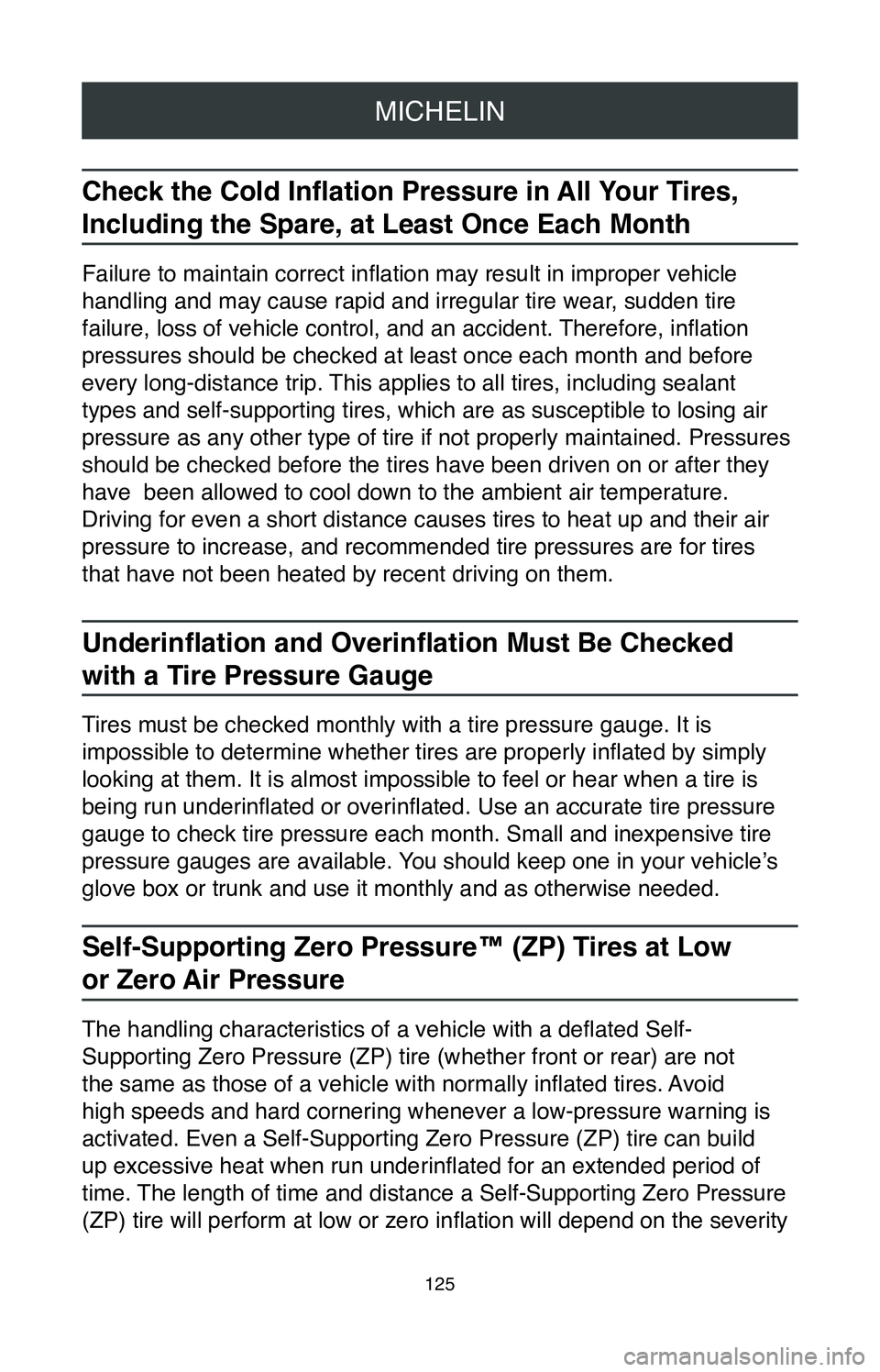
MICHELIN
125
Check the Cold Inflation Pressure in All Your Tires,
Including the Spare, at Least Once Each Month
Failure to maintain correct inflation may result in improper vehicle
handling and may cause rapid and irregular tire wear, sudden tire
failure, loss of vehicle control, and an accident. Therefore, inflation
pressures should be checked at least once each month and before
every long-distance trip. This applies to all tires, including sealant
types and self-supporting tires, which are as susceptible to losing air
pressure as any other type of tire if not properly maintained. Pressures\
should be checked before the tires have been driven on or after they
have been allowed to cool down to the ambient air temperature.
Driving for even a short distance causes tires to heat up and their air \
pressure to increase, and recommended tire pressures are for tires
that have not been heated by recent driving on them.
Underinflation and Overinflation Must Be Checked
with a Tire Pressure Gauge
Tires must be checked monthly with a tire pressure gauge. It is
impossible to determine whether tires are properly inflated by simply
looking at them. It is almost impossible to feel or hear when a tire is \
being run underinflated or overinflated. Use an accurate tire pressure
gauge to check tire pressure each month. Small and inexpensive tire
pressure gauges are available. You should keep one in your vehicle’s
glove box or trunk and use it monthly and as otherwise needed.
Self-Supporting Zero Pressure‚ĄĘ (ZP) Tires at Low
or Zero Air Pressure
The handling characteristics of a vehicle with a deflated Self-
Supporting Zero Pressure (ZP) tire (whether front or rear) are not
the same as those of a vehicle with normally inflated tires. Avoid
high speeds and hard cornering whenever a low-pressure warning is
activated. Even a Self-Supporting Zero Pressure (ZP) tire can build
up excessive heat when run underinflated for an extended period of
time. The length of time and distance a Self-Supporting Zero Pressure
(ZP) tire will perform at low or zero inflation will depend on the severity
Page 128 of 260
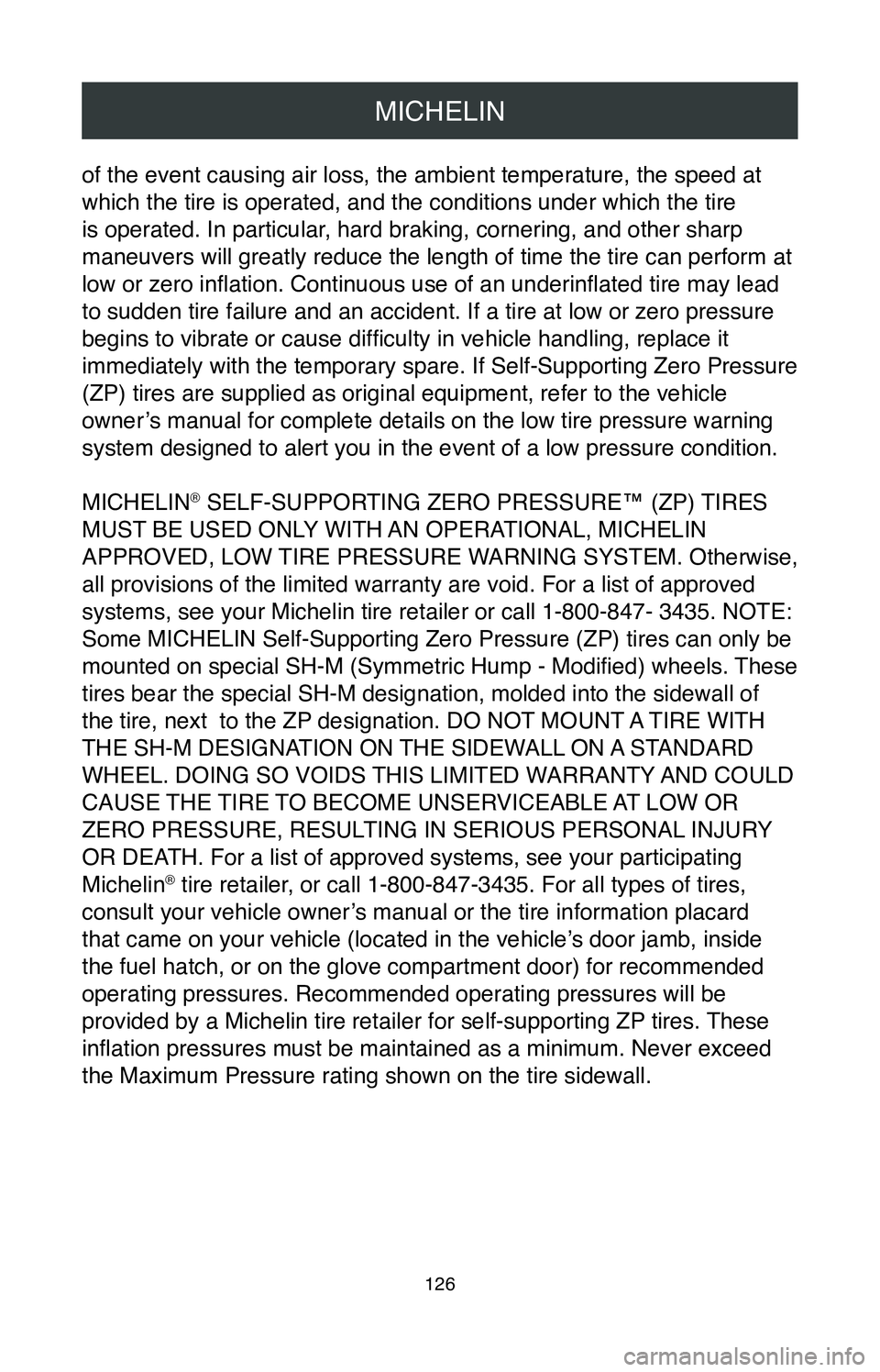
MICHELIN
126
of the event causing air loss, the ambient temperature, the speed at
which the tire is operated, and the conditions under which the tire
is operated. In particular, hard braking, cornering, and other sharp
maneuvers will greatly reduce the length of time the tire can perform at\
low or zero inflation. Continuous use of an underinflated tire may lead
to sudden tire failure and an accident. If a tire at low or zero pressur\
e
begins to vibrate or cause difficulty in vehicle handling, replace it
immediately with the temporary spare. If Self-Supporting Zero Pressure
(ZP) tires are supplied as original equipment, refer to the vehicle
owner’s manual for complete details on the low tire pressure warning
system designed to alert you in the event of a low pressure condition.
MICHELIN
¬ģ SELF-SUPPORTING ZERO PRESSURE‚ĄĘ (ZP) TIRES
MUST BE USED ONLY WITH AN OPERATIONAL, MICHELIN
APPROVED, LOW TIRE PRESSURE WARNING SYSTEM. Otherwise,
all provisions of the limited warranty are void. For a list of approved \
systems, see your Michelin tire retailer or call 1-800-847- 3435. NOTE:
Some MICHELIN Self-Supporting Zero Pressure (ZP) tires can only be
mounted on special SH-M (Symmetric Hump - Modified) wheels. These
tires bear the special SH-M designation, molded into the sidewall of
the tire, next to the ZP designation. DO NOT MOUNT A TIRE WITH
THE SH-M DESIGNATION ON THE SIDEWALL ON A STANDARD
WHEEL. DOING SO VOIDS THIS LIMITED WARRANTY AND COULD
CAUSE THE TIRE TO BECOME UNSERVICEABLE AT LOW OR
ZERO PRESSURE, RESULTING IN SERIOUS PERSONAL INJURY
OR DEATH. For a list of approved systems, see your participating
Michelin
¬ģ tire retailer, or call 1-800-847-3435. For all types of tires,
consult your vehicle owner’s manual or the tire information placard
that came on your vehicle (located in the vehicle’s door jamb, inside
the fuel hatch, or on the glove compartment door) for recommended
operating pressures. Recommended operating pressures will be
provided by a Michelin tire retailer for self-supporting ZP tires. These
inflation pressures must be maintained as a minimum. Never exceed
the Maximum Pressure rating shown on the tire sidewall.
Page 129 of 260
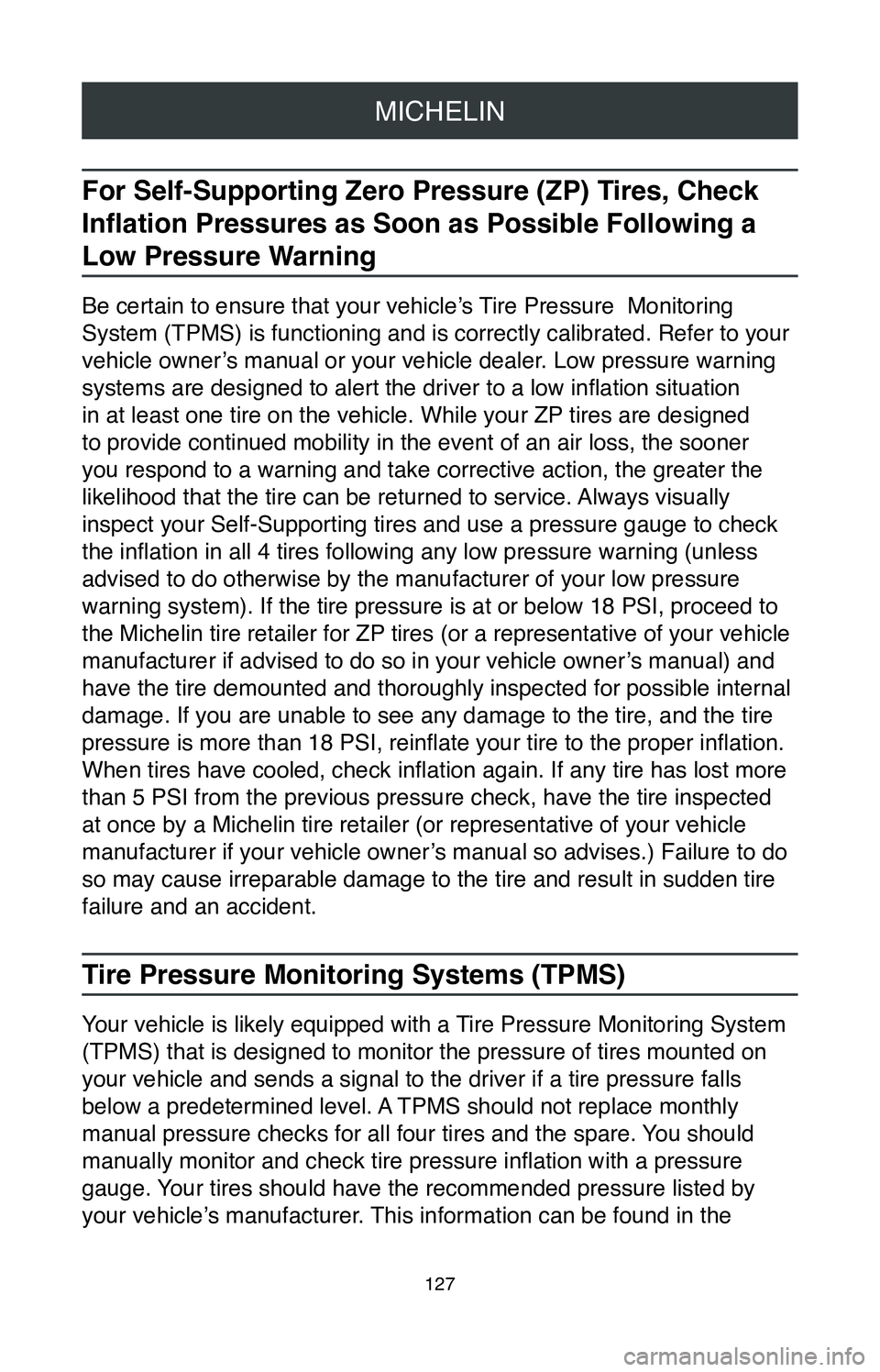
MICHELIN
127
For Self-Supporting Zero Pressure (ZP) Tires, Check
Inflation Pressures as Soon as Possible Following a
Low Pressure Warning
Be certain to ensure that your vehicle’s Tire Pressure Monitoring
System (TPMS) is functioning and is correctly calibrated. Refer to your
vehicle owner’s manual or your vehicle dealer. Low pressure warning
systems are designed to alert the driver to a low inflation situation
in at least one tire on the vehicle. While your ZP tires are designed
to provide continued mobility in the event of an air loss, the sooner
you respond to a warning and take corrective action, the greater the
likelihood that the tire can be returned to service. Always visually
inspect your Self-Supporting tires and use a pressure gauge to check
the inflation in all 4 tires following any low pressure warning (unless
advised to do otherwise by the manufacturer of your low pressure
warning system). If the tire pressure is at or below 18 PSI, proceed to\
the Michelin tire retailer for ZP tires (or a representative of your vehicle
manufacturer if advised to do so in your vehicle owner’s manual) and
have the tire demounted and thoroughly inspected for possible internal
damage. If you are unable to see any damage to the tire, and the tire
pressure is more than 18 PSI, reinflate your tire to the proper inflation.
When tires have cooled, check inflation again. If any tire has lost more
than 5 PSI from the previous pressure check, have the tire inspected
at once by a Michelin tire retailer (or representative of your vehicle
manufacturer if your vehicle owner’s manual so advises.) Failure to do
so may cause irreparable damage to the tire and result in sudden tire
failure and an accident.
Tire Pressure Monitoring Systems (TPMS)
Your vehicle is likely equipped with a Tire Pressure Monitoring System
(TPMS) that is designed to monitor the pressure of tires mounted on
your vehicle and sends a signal to the driver if a tire pressure falls
below a predetermined level. A TPMS should not replace monthly
manual pressure checks for all four tires and the spare. You should
manually monitor and check tire pressure inflation with a pressure
gauge. Your tires should have the recommended pressure listed by
your vehicle’s manufacturer. This information can be found in the
Page 130 of 260
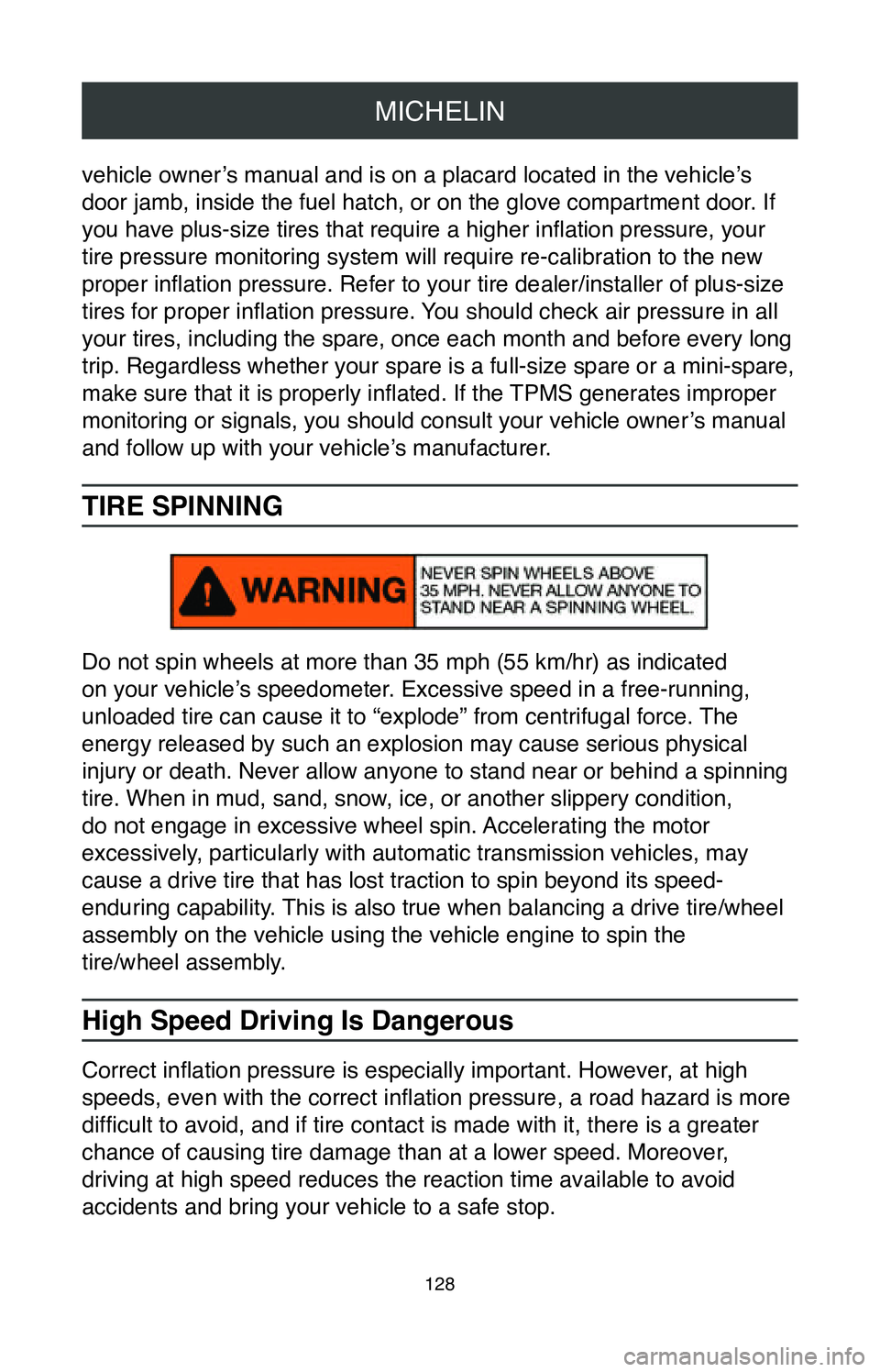
MICHELIN
128
vehicle owner’s manual and is on a placard located in the vehicle’s
door jamb, inside the fuel hatch, or on the glove compartment door. If
you have plus-size tires that require a higher inflation pressure, your
tire pressure monitoring system will require re-calibration to the new
proper inflation pressure. Refer to your tire dealer/installer of plus-size
tires for proper inflation pressure. You should check air pressure in all
your tires, including the spare, once each month and before every long
trip. Regardless whether your spare is a full-size spare or a mini-spare,
make sure that it is properly inflated. If the TPMS generates improper
monitoring or signals, you should consult your vehicle owner’s manual
and follow up with your vehicle’s manufacturer.
TIRE SPINNING
Do not spin wheels at more than 35 mph (55 km/hr) as indicated
on your vehicle’s speedometer. Excessive speed in a free-running,
unloaded tire can cause it to ‚Äúexplode‚ÄĚ from centrifugal force. The
energy released by such an explosion may cause serious physical
injury or death. Never allow anyone to stand near or behind a spinning
tire. When in mud, sand, snow, ice, or another slippery condition,
do not engage in excessive wheel spin. Accelerating the motor
excessively, particularly with automatic transmission vehicles, may
cause a drive tire that has lost traction to spin beyond its speed-
enduring capability. This is also true when balancing a drive tire/wheel
assembly on the vehicle using the vehicle engine to spin the
tire/wheel assembly.
High Speed Driving Is Dangerous
Correct inflation pressure is especially important. However, at high
speeds, even with the correct inflation pressure, a road hazard is more
difficult to avoid, and if tire contact is made with it, there is a greater
chance of causing tire damage than at a lower speed. Moreover,
driving at high speed reduces the reaction time available to avoid
accidents and bring your vehicle to a safe stop.
Page 131 of 260
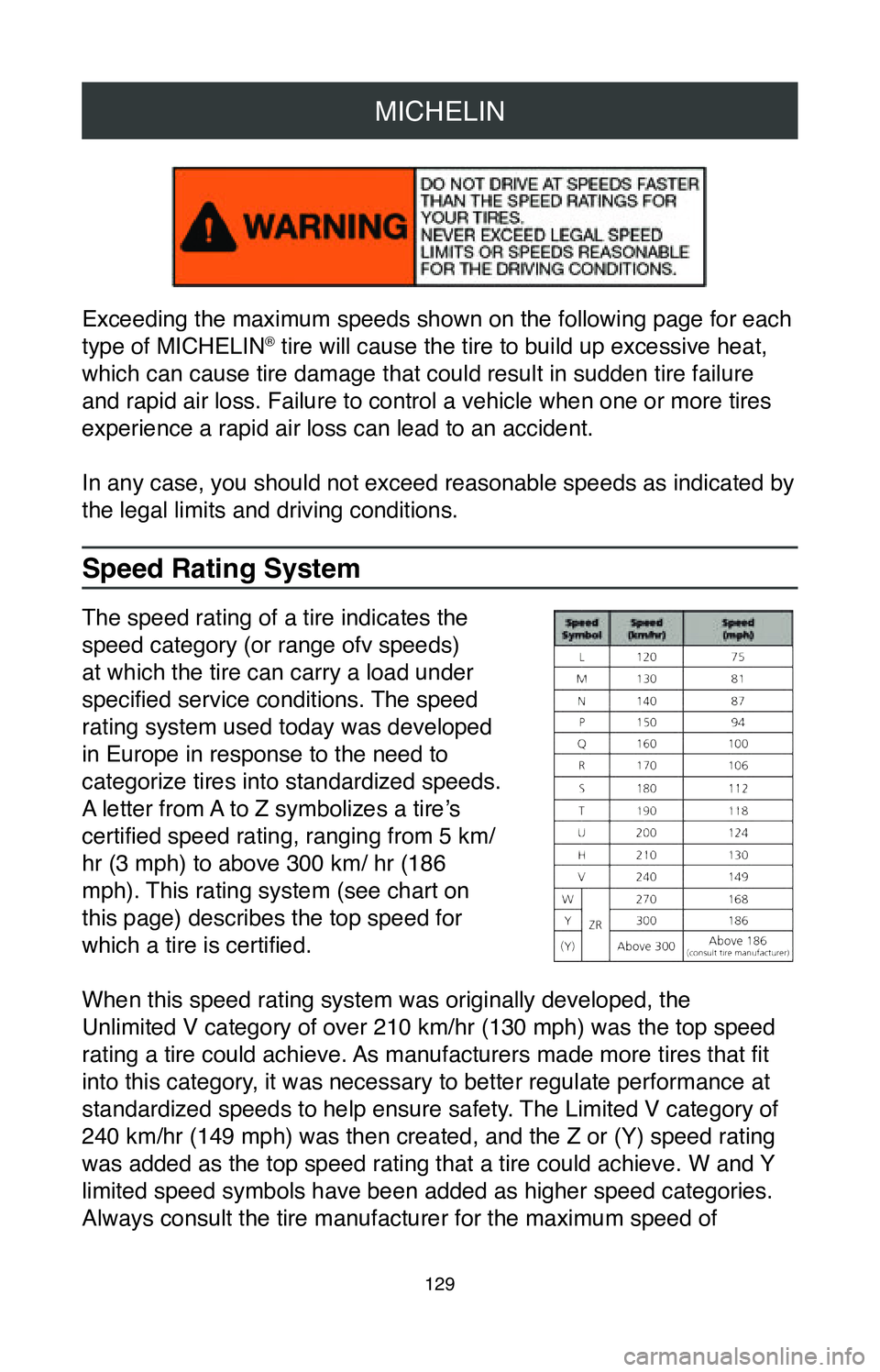
MICHELIN
129
Exceeding the maximum speeds shown on the following page for each
type of MICHELIN¬ģ tire will cause the tire to build up excessive heat,
which can cause tire damage that could result in sudden tire failure
and rapid air loss. Failure to control a vehicle when one or more tires \
experience a rapid air loss can lead to an accident.
In any case, you should not exceed reasonable speeds as indicated by
the legal limits and driving conditions.
Speed Rating System
The speed rating of a tire indicates the
speed category (or range of v speeds)
at which the tire can carry a load under
specified service conditions. The speed
rating system used today was developed
in Europe in response to the need to
categorize tires into standardized speeds.
A letter from A to Z symbolizes a tire’s
certified speed rating, ranging from 5 km/
hr (3 mph) to above 300 km/ hr (186
mph). This rating system (see chart on
this page) describes the top speed for
which a tire is certified.
When this speed rating system was originally developed, the
Unlimited V category of over 210 km/hr (130 mph) was the top speed
rating a tire could achieve. As manufacturers made more tires that fit
into this category, it was necessary to better regulate performance at
standardized speeds to help ensure safety. The Limited V category of
240 km/hr (149 mph) was then created, and the Z or (Y) speed rating
was added as the top speed rating that a tire could achieve. W and Y
limited speed symbols have been added as higher speed categories.
Always consult the tire manufacturer for the maximum speed of
Page 132 of 260
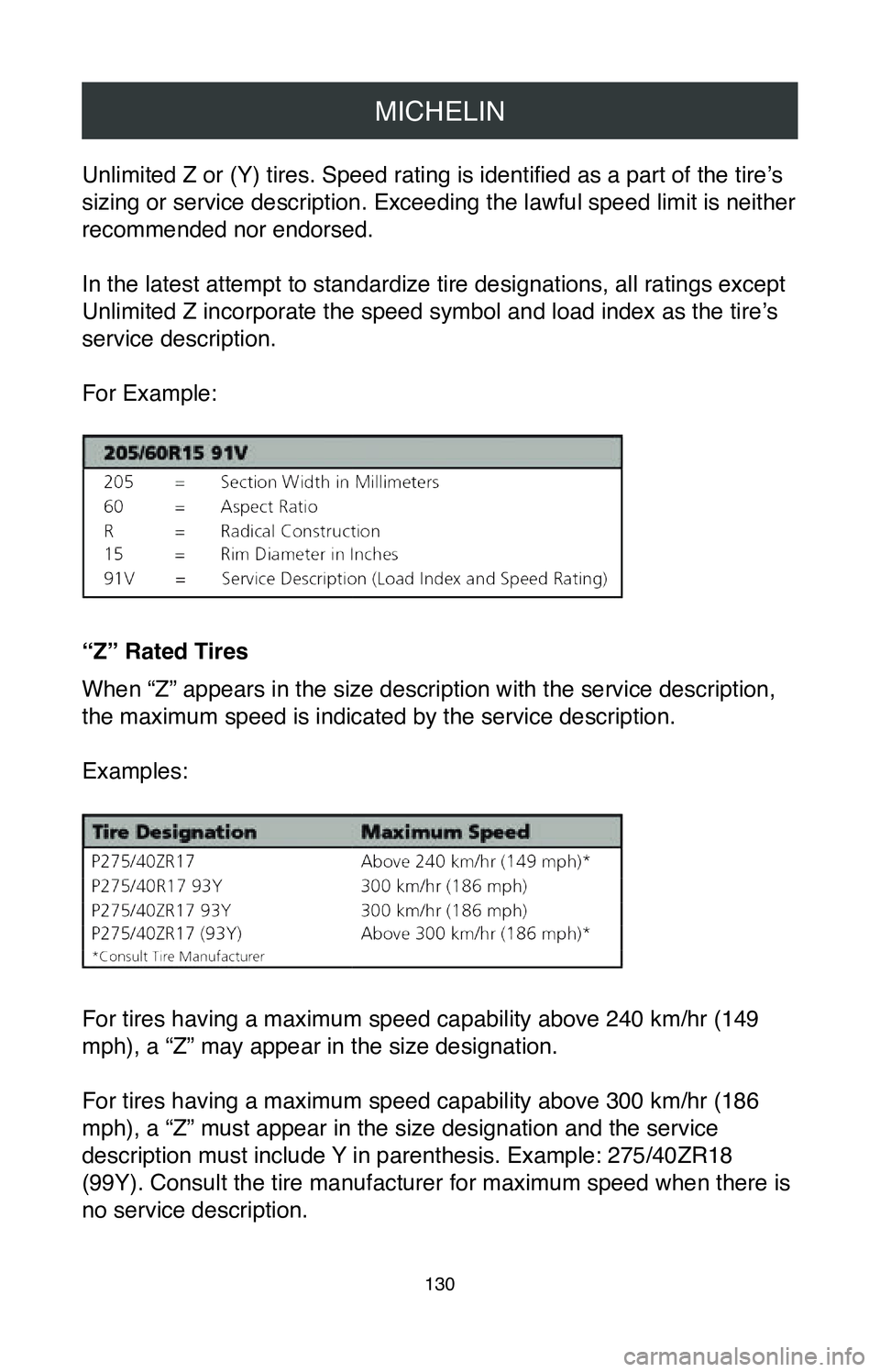
MICHELIN
130
Unlimited Z or (Y) tires. Speed rating is identified as a part of the tire’s
sizing or service description. Exceeding the lawful speed limit is neith\
er
recommended nor endorsed.
In the latest attempt to standardize tire designations, all ratings exce\
pt
Unlimited Z incorporate the speed symbol and load index as the tire’ s
service description.
For Example:
‚ÄúZ‚ÄĚ Rated Tires
When ‚ÄúZ‚ÄĚ appears in the size description with the service descript\
ion,
the maximum speed is indicated by the service description.
Examples:
For tires having a maximum speed capability above 240 km/hr (149
mph), a ‚ÄúZ‚ÄĚ may appear in the size designation.
For tires having a maximum speed capability above 300 km/hr (186
mph), a ‚ÄúZ‚ÄĚ must appear in the size designation and the service
description must include Y in parenthesis. Example: 275/40ZR18
(99Y). Consult the tire manufacturer for maximum speed when there is
no service description.
Page 133 of 260
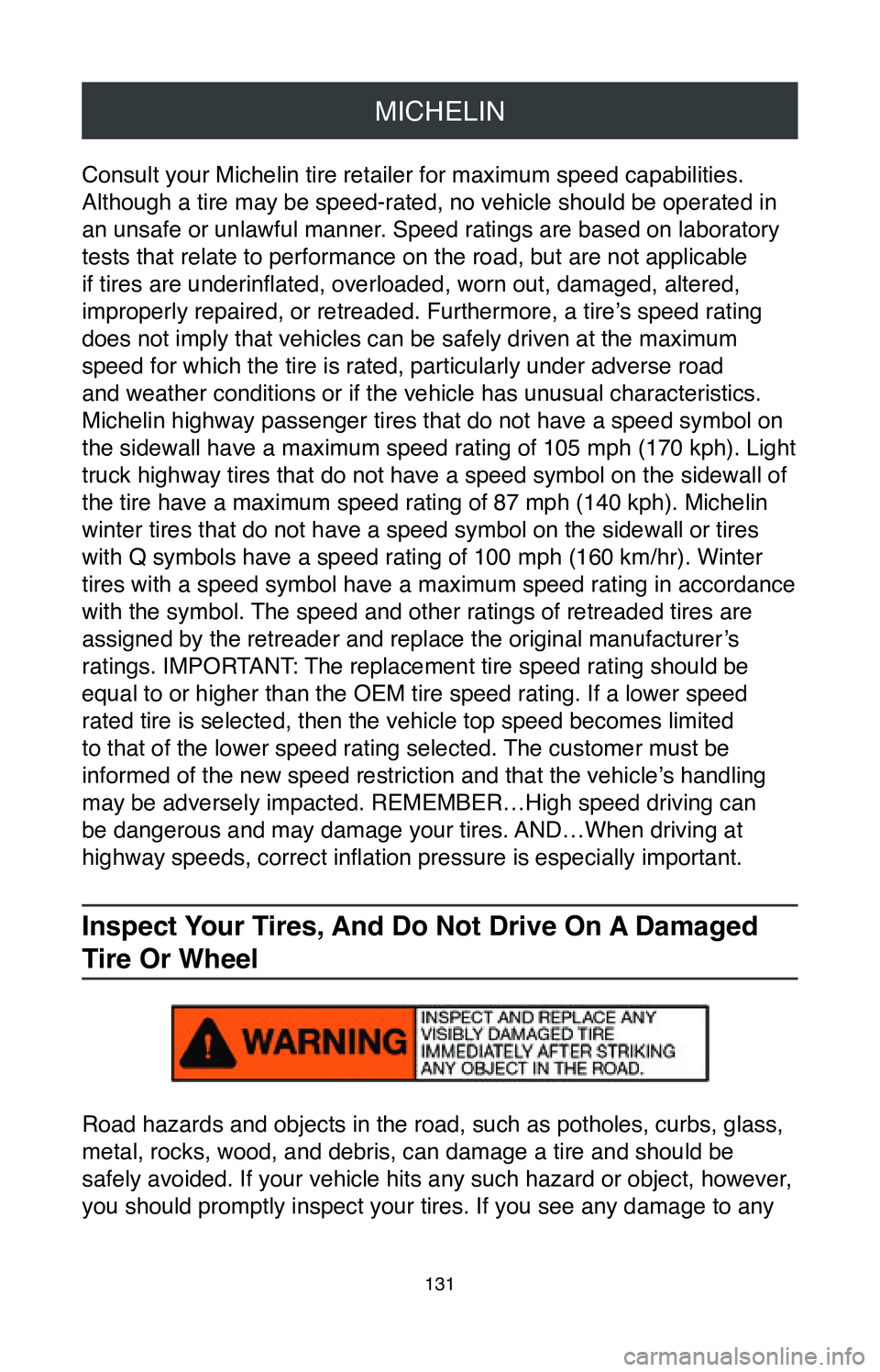
MICHELIN
131
Consult your Michelin tire retailer for maximum speed capabilities.
Although a tire may be speed-rated, no vehicle should be operated in
an unsafe or unlawful manner. Speed ratings are based on laboratory
tests that relate to performance on the road, but are not applicable
if tires are underinflated, overloaded, worn out, damaged, altered,
improperly repaired, or retreaded. Furthermore, a tire’s speed rating
does not imply that vehicles can be safely driven at the maximum
speed for which the tire is rated, particularly under adverse road
and weather conditions or if the vehicle has unusual characteristics.
Michelin highway passenger tires that do not have a speed symbol on
the sidewall have a maximum speed rating of 105 mph (170 kph). Light
truck highway tires that do not have a speed symbol on the sidewall of
the tire have a maximum speed rating of 87 mph (140 kph). Michelin
winter tires that do not have a speed symbol on the sidewall or tires
with Q symbols have a speed rating of 100 mph (160 km/hr). Winter
tires with a speed symbol have a maximum speed rating in accordance
with the symbol. The speed and other ratings of retreaded tires are
assigned by the retreader and replace the original manufacturer’s
ratings. IMPORTANT: The replacement tire speed rating should be
equal to or higher than the OEM tire speed rating. If a lower speed
rated tire is selected, then the vehicle top speed becomes limited
to that of the lower speed rating selected. The customer must be
informed of the new speed restriction and that the vehicle’s handling
may be adversely impacted. REMEMBER…High speed driving can
be dangerous and may damage your tires. AND…When driving at
highway speeds, correct inflation pressure is especially important.
Inspect Your Tires, And Do Not Drive On A Damaged
Tire Or Wheel
Road hazards and objects in the road, such as potholes, curbs, glass,
metal, rocks, wood, and debris, can damage a tire and should be
safely avoided. If your vehicle hits any such hazard or object, however,
you should promptly inspect your tires. If you see any damage to any
Page 134 of 260
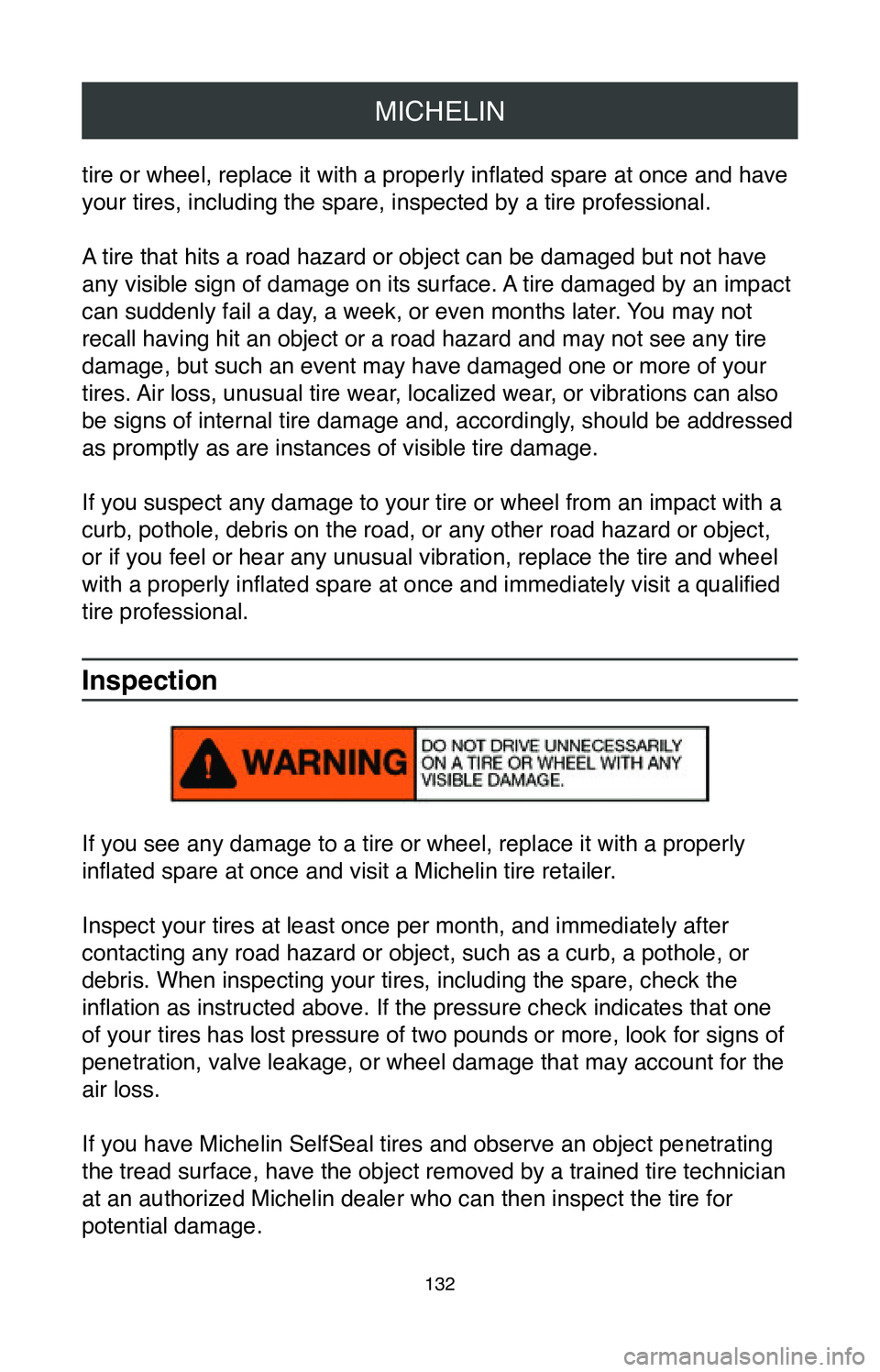
MICHELIN
132
tire or wheel, replace it with a properly inflated spare at once and have
your tires, including the spare, inspected by a tire professional.
A tire that hits a road hazard or object can be damaged but not have
any visible sign of damage on its surface. A tire damaged by an impact
can suddenly fail a day, a week, or even months later. You may not
recall having hit an object or a road hazard and may not see any tire
damage, but such an event may have damaged one or more of your
tires. Air loss, unusual tire wear, localized wear, or vibrations can also
be signs of internal tire damage and, accordingly, should be addressed
as promptly as are instances of visible tire damage.
If you suspect any damage to your tire or wheel from an impact with a
curb, pothole, debris on the road, or any other road hazard or object,
or if you feel or hear any unusual vibration, replace the tire and wheel\
with a properly inflated spare at once and immediately visit a qualified
tire professional.
Inspection
If you see any damage to a tire or wheel, replace it with a properly
inflated spare at once and visit a Michelin tire retailer.
Inspect your tires at least once per month, and immediately after
contacting any road hazard or object, such as a curb, a pothole, or
debris. When inspecting your tires, including the spare, check the
inflation as instructed above. If the pressure check indicates that one
of your tires has lost pressure of two pounds or more, look for signs of\
penetration, valve leakage, or wheel damage that may account for the
air loss.
If you have Michelin SelfSeal tires and observe an object penetrating
the tread surface, have the object removed by a trained tire technician
at an authorized Michelin dealer who can then inspect the tire for
potential damage.
Page 135 of 260
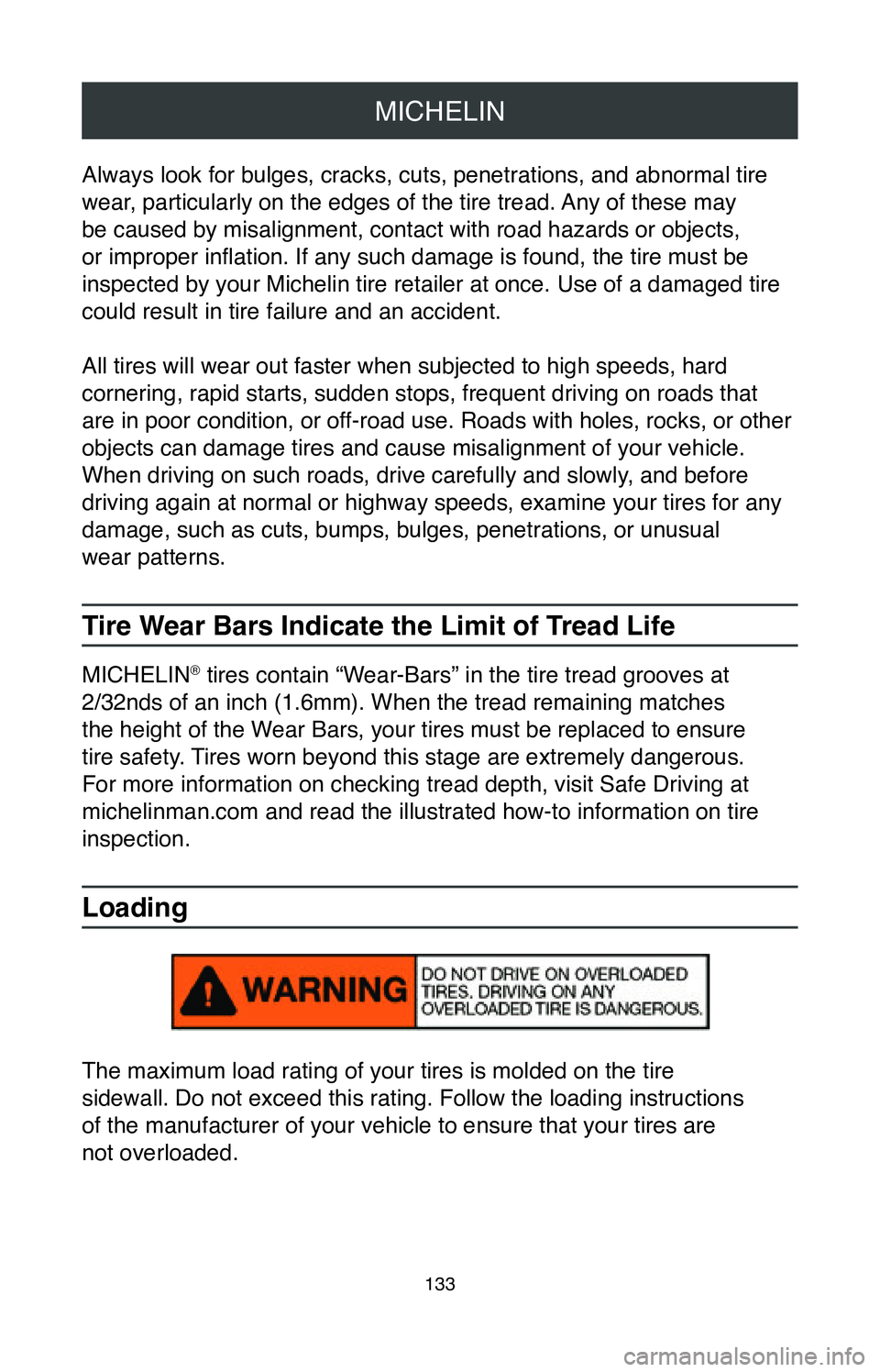
MICHELIN
133
Always look for bulges, cracks, cuts, penetrations, and abnormal tire
wear, particularly on the edges of the tire tread. Any of these may
be caused by misalignment, contact with road hazards or objects,
or improper inflation. If any such damage is found, the tire must be
inspected by your Michelin tire retailer at once. Use of a damaged tire \
could result in tire failure and an accident.
All tires will wear out faster when subjected to high speeds, hard
cornering, rapid starts, sudden stops, frequent driving on roads that
are in poor condition, or off-road use. Roads with holes, rocks, or other
objects can damage tires and cause misalignment of your vehicle.
When driving on such roads, drive carefully and slowly, and before
driving again at normal or highway speeds, examine your tires for any
damage, such as cuts, bumps, bulges, penetrations, or unusual
wear patterns.
Tire Wear Bars Indicate the Limit of Tread Life
MICHELIN¬ģ tires contain ‚ÄúWear-Bars‚ÄĚ in the tire tread grooves at
2/32nds of an inch (1.6mm). When the tread remaining matches
the height of the Wear Bars, your tires must be replaced to ensure
tire safety. Tires worn beyond this stage are extremely dangerous.
For more information on checking tread depth, visit Safe Driving at
michelinman.com and read the illustrated how-to information on tire
inspection.
Loading
The maximum load rating of your tires is molded on the tire
sidewall. Do not exceed this rating. Follow the loading instructions
of the manufacturer of your vehicle to ensure that your tires are
not overloaded.
Page 136 of 260
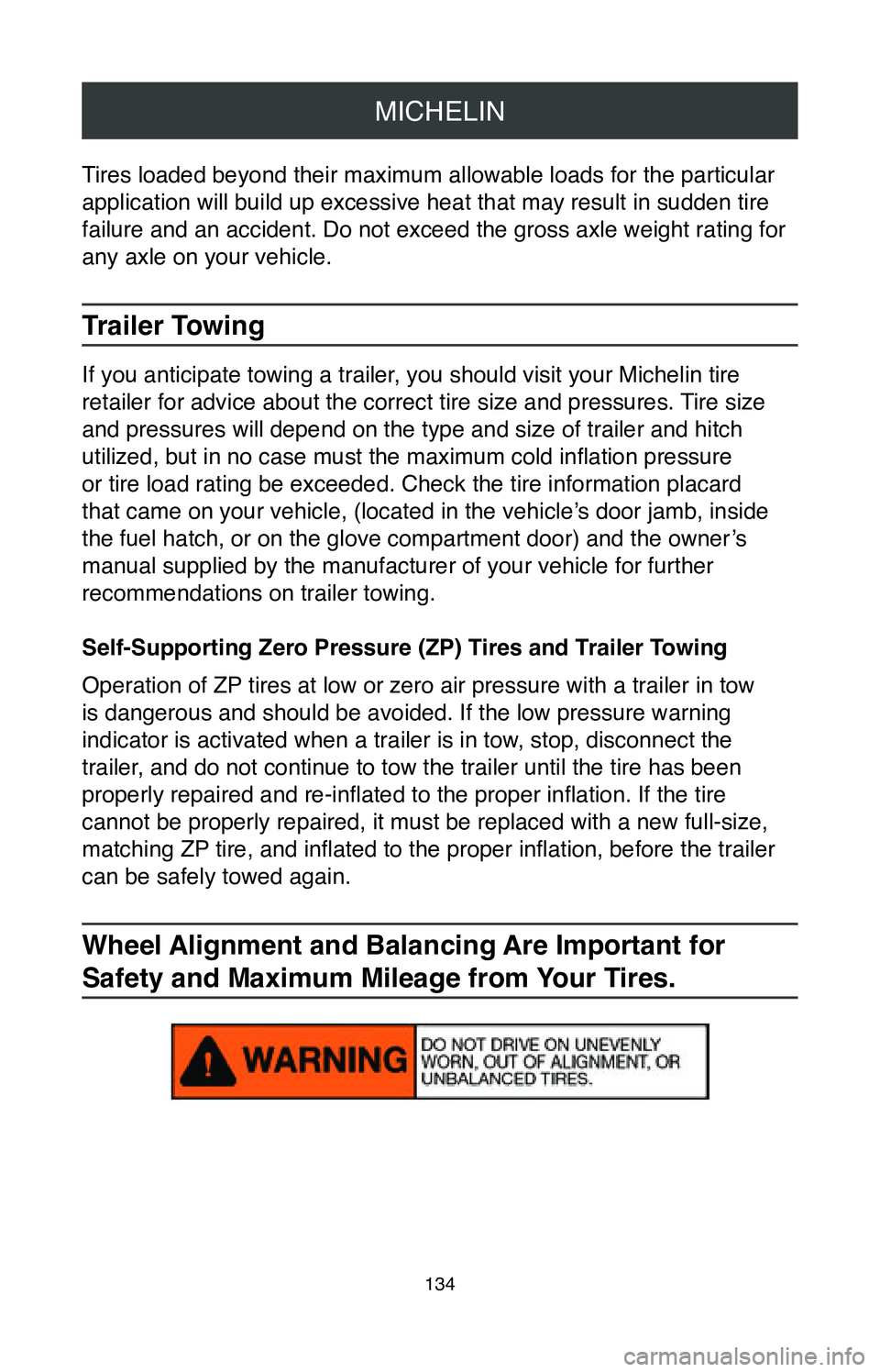
MICHELIN
134
Tires loaded beyond their maximum allowable loads for the particular
application will build up excessive heat that may result in sudden tire \
failure and an accident. Do not exceed the gross axle weight rating for \
any axle on your vehicle.
Trailer Towing
If you anticipate towing a trailer, you should visit your Michelin tire
retailer for advice about the correct tire size and pressures. Tire size
and pressures will depend on the type and size of trailer and hitch
utilized, but in no case must the maximum cold inflation pressure
or tire load rating be exceeded. Check the tire information placard
that came on your vehicle, (located in the vehicle’s door jamb, inside
the fuel hatch, or on the glove compartment door) and the owner’s
manual supplied by the manufacturer of your vehicle for further
recommendations on trailer towing.
Self-Supporting Zero Pressure (ZP) Tires and Trailer Towing
Operation of ZP tires at low or zero air pressure with a trailer in tow
is dangerous and should be avoided. If the low pressure warning
indicator is activated when a trailer is in tow, stop, disconnect the
trailer, and do not continue to tow the trailer until the tire has been
properly repaired and re-inflated to the proper inflation. If the tire
cannot be properly repaired, it must be replaced with a new full-size,
matching ZP tire, and inflated to the proper inflation, before the trailer
can be safely towed again.
Wheel Alignment and Balancing Are Important for
Safety and Maximum Mileage from Your Tires.